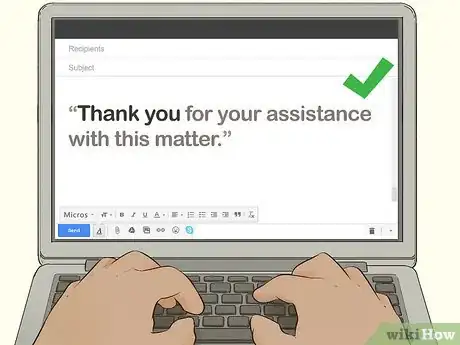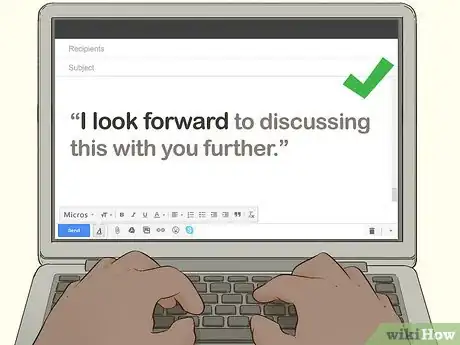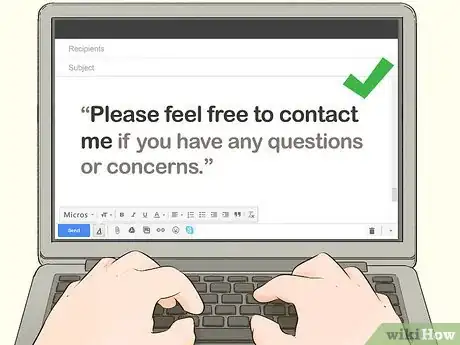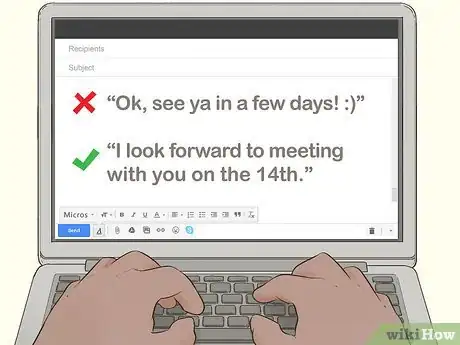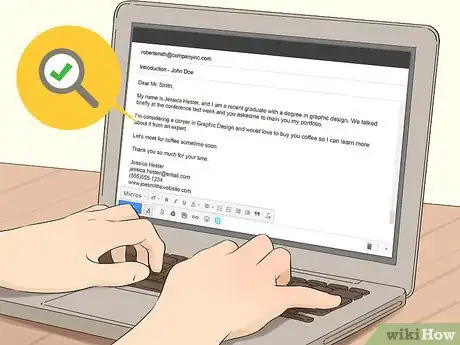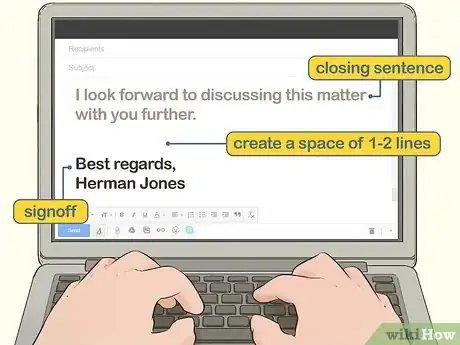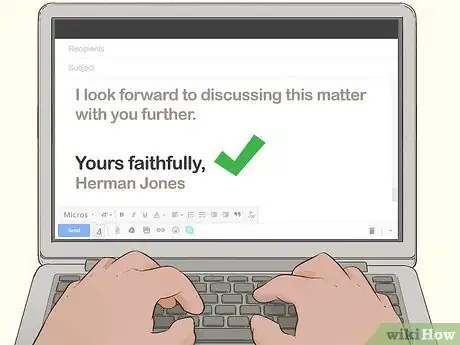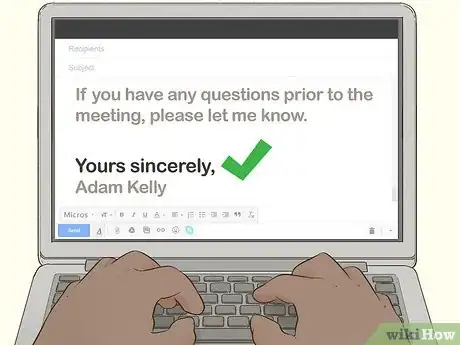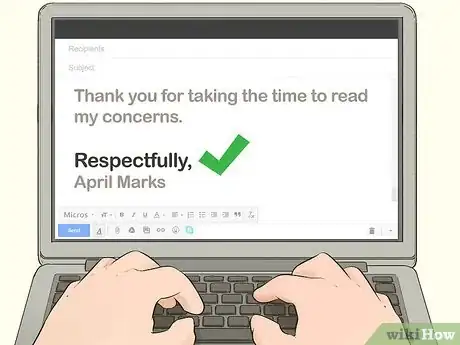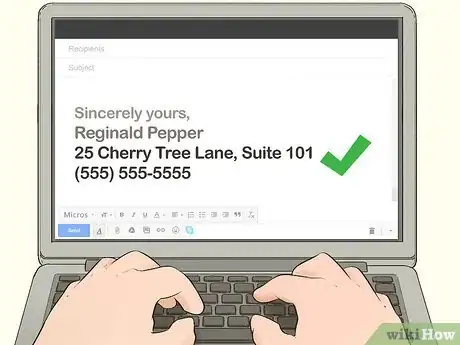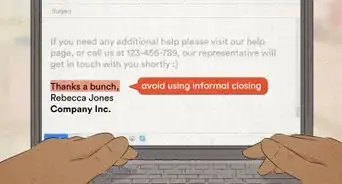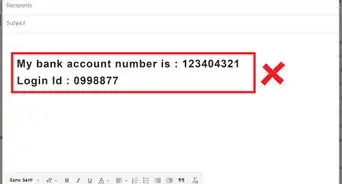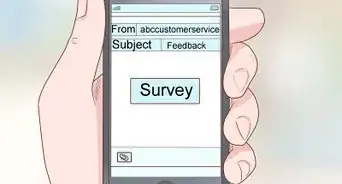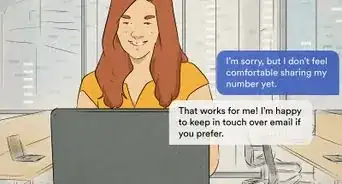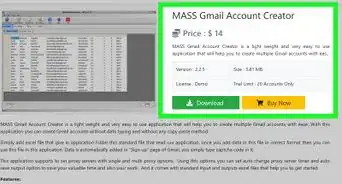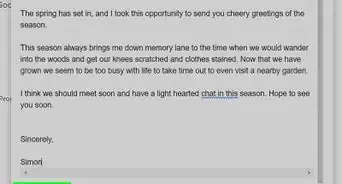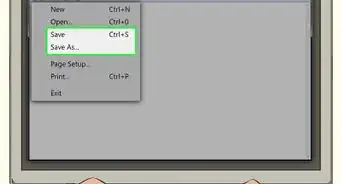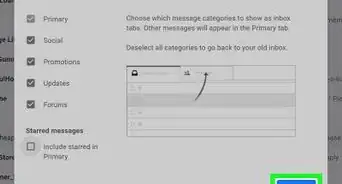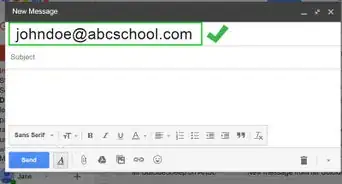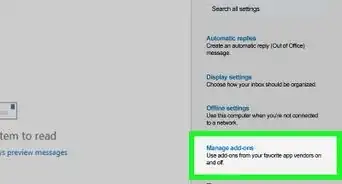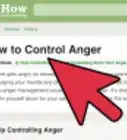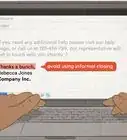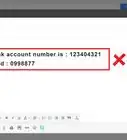This article was co-authored by wikiHow staff writer, Megaera Lorenz, PhD. Megaera Lorenz is an Egyptologist and Writer with over 20 years of experience in public education. In 2017, she graduated with her PhD in Egyptology from The University of Chicago, where she served for several years as a content advisor and program facilitator for the Oriental Institute Museum’s Public Education office. She has also developed and taught Egyptology courses at The University of Chicago and Loyola University Chicago.
This article has been viewed 278,776 times.
Learn more...
If you’re writing a formal email, you may find yourself struggling with the best way to end your message. Fortunately, your ending doesn’t have to be anything elaborate. Finish the body of your message with a concise, formally written ending line that sums up the purpose of your email. When that’s done, wrap up the email with an appropriate closing based on how well you know the recipient. Don’t forget to sign off with your name and contact information.
Steps
Composing a Closing Sentence
-
1End with a “thanks” if your recipient is helping you. When you’re closing a formal email, consider the main purpose of the message. In many cases, a simple expression of gratitude is an appropriate way to end the email.[1]
- For example, if your recipient has helped you or is helping you with something, try: “Thank you for your assistance with this matter.”
- You can also thank your recipient simply for giving you their time and attention. For example, “I appreciate your consideration,” or “Thank you for taking the time to review this issue.”
-
2Close with a call to action if you’re expecting a response. In some cases, you may need to prompt your recipient to take further action or respond to you in some way. You can use the final line of your email to state or reiterate what you need from them.[2]
- For example, if you’re expecting your recipient to get back to you, say something like: “I look forward to discussing this with you further.”
- You can also request some other type of action. For example, “Please finish the report and send it to me at your earliest convenience.”
Advertisement -
3Let the recipient know if you plan to take action. If the recipient of the email needs something from you, then the final line of the email is a good place to address that. Assure them that you are taking the requested action or that you are planning to do so.[3]
- For example, “I will send the completed forms to you by next Friday.”
- You can also use the closing line as an opportunity to offer further assistance or information. For example: “Please feel free to contact me if you have any questions or concerns.”
-
4Use formal language. When closing your email, stick to an appropriately formal tone. Use correct grammar and formal vocabulary, and avoid slang or conversational language.[4]
- For example, if you’re setting up a meeting, you might close with something like, “I look forward to meeting with you on the 14th.” Avoid chatty ending lines, such as, “Ok, see ya in a few days! :)”
Tip: In a formal email, avoid using contractions (such as I’m, don’t, can’t or isn’t), since these can also make your writing sound chatty and informal.
-
5Check carefully for typos and grammatical errors. Before sending your email, look it over for problems, such as spelling errors, typos, grammatical mistakes, and incorrect punctuation. If possible, have someone else look at your message to see if they can spot anything you might have missed.[5]
- While many email programs have built-in spell checkers, be aware that these can’t catch all spelling errors. For example, your spell checker may not correct common confusions between words that sound the same but are spelled differently and have different meanings (like “compliment” and “complement”).
Signing off on Your Email
-
1Put 1-2 lines between your closing sentence and the signoff. Once you’ve completed the body of the email, hit the “Enter” key once or twice to create a space between the final line and your signoff. In most emails, the sign-off should be left justified (or up against the left margin of the page).[6]
- For example:
I look forward to discussing this matter with you further.
Best regards,
Herman Jones
- For example:
-
2End with “Yours faithfully” or “Yours truly” if you don’t know the recipient’s name. If you’re writing a very formal email and you don’t know the name of the recipient, you can use one of these sign offs. These are good choices if you started your email with something like “Dear Sir,” “Dear Madam,” or “To Whom It May Concern.”[7]
- While you can choose either of these options, keep in mind that “Yours faithfully” is more common in British English, while “Yours truly” is more common among American English speakers.
- Make sure to capitalize just the first word in the signoff (“Yours”).
-
3Close with “Yours sincerely” or “Sincerely yours” if you know their name. “Yours sincerely” and its variants are strong options when you’re closing a formal email to a known or named recipient. Use one of these sign-offs if you started your email with “Dear Ms. Smith” or something similar.[8]
- “Yours sincerely” is the most typical format in British English, while American English speakers may use “Sincerely yours” or just “Sincerely.”
- Whether you use “Yours sincerely” or “Sincerely yours,” just capitalize the first letter of the first word.
-
4Sign off with “Best regards” or “Kind regards” for a more general closure. “Best regards” and “Kind regards” are slightly less formal than endings like “Sincerely yours” or “Yours truly.” These work well for most formal emails, but may be best for messages to people you know slightly or have corresponded with before.[9]
Tip: While some writers consider “Kind regards” to be more formal than “Best regards,” others use them interchangeably. Use your judgment to decide which one feels most appropriate to you.
-
5Use “Respectfully” to strike an ultra-formal note. For most emails, “Respectfully” or “Respectfully yours” may come off as a little too formal. There are some situations where these are appropriate, however. For example, you might use one of these closings if you’re writing to a government official or a member of the clergy.[10]
- This type of closer indicates that you are in a subservient position to the recipient of the email. It’s unnecessary to use “Respectfully” for typical business emails or messages to teachers, colleagues, or your boss (unless they are, for example, a president or prime minister).[11]
-
6Finish with your full name. Place a comma after your signoff, start a new line, and finish with your first and last name. You might also wish to include your job title, if applicable.[12]
- For example, you might sign off with:
Best regards,
Linda Jones
Supervising Editor
- For example, you might sign off with:
-
7Include your contact information after the signature. After your full name, include any contact information you would like your recipient to have. This could be your email address, phone number, mailing address, or any combination of the above.[13] For example:
- Sincerely yours,
Reginald Pepper
25 Cherry Tree Lane, Suite 101
(555) 555-5555 - If you have an automatic signature set up with your email program, make sure it doesn’t contain anything that might be inappropriate for a formal email (such as humorous quotes or flashy graphics). Stick to the basics, like your name, job title, and contact information.[14]
- Sincerely yours,
References
- ↑ https://www.menlo.edu/wp-content/uploads/2015/03/writing-a-formal-email.pdf
- ↑ https://www.menlo.edu/wp-content/uploads/2015/03/writing-a-formal-email.pdf
- ↑ https://www.menlo.edu/wp-content/uploads/2015/03/writing-a-formal-email.pdf
- ↑ https://www.menlo.edu/wp-content/uploads/2015/03/writing-a-formal-email.pdf
- ↑ https://www.menlo.edu/wp-content/uploads/2015/03/writing-a-formal-email.pdf
- ↑ https://en.oxforddictionaries.com/writing-help/how-to-lay-out-a-letter
- ↑ https://www.dailywritingtips.com/yours-faithfully-or-yours-sincerely/
- ↑ https://www.dailywritingtips.com/yours-faithfully-or-yours-sincerely/
- ↑ https://www.dailywritingtips.com/email-etiquette/
- ↑ https://www.businessinsider.com/how-to-sign-off-on-an-email-2015-6#yours-faithfully-23
- ↑ https://emilypost.com/advice/effective-business-letters/
- ↑ https://www.menlo.edu/wp-content/uploads/2015/03/writing-a-formal-email.pdf
- ↑ https://www.menlo.edu/wp-content/uploads/2015/03/writing-a-formal-email.pdf
- ↑ https://www.dailywritingtips.com/email-etiquette/
About This Article
To end a formal email, thank the person for their time if they're helping you, or include a call to action if you're expecting a response from the recipient. If the recipient needs something from you, be sure to address that in the final line of the email. For business emails, sign off with "Sincerely," "Best regards," or "Respectfully." Then, place a comma after your signoff, start a new line, and finish with your first and last name. For tips on signing off when your email is not business related, read on!
